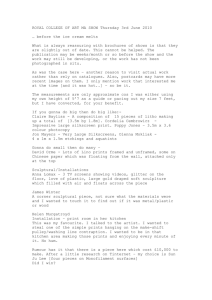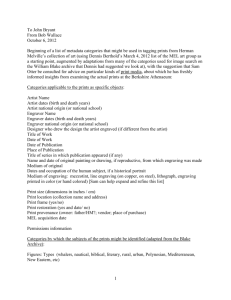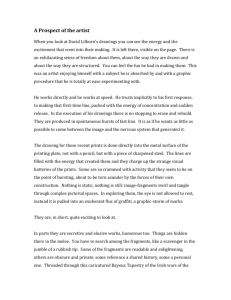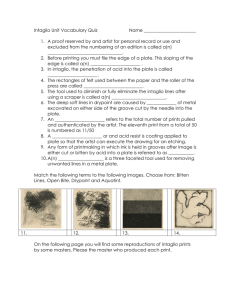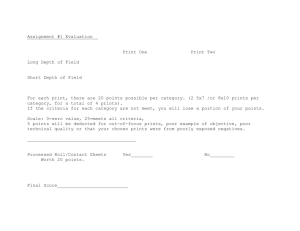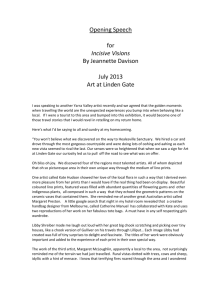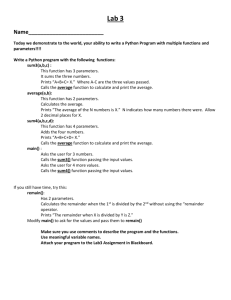MATERIAL, METHOD, MEDIuM
advertisement
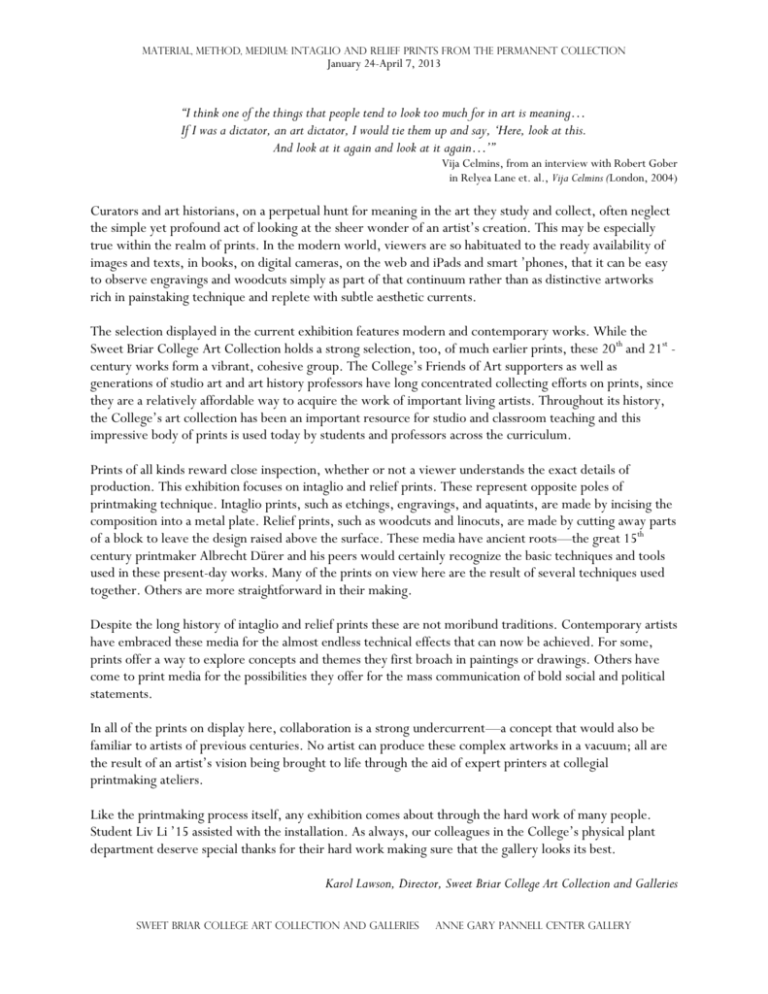
Material, Method, Medium: Intaglio and Relief Prints from the Permanent Collection January 24-April 7, 2013 “I think one of the things that people tend to look too much for in art is meaning… If I was a dictator, an art dictator, I would tie them up and say, „Here, look at this. And look at it again and look at it again…‟” Vija Celmins, from an interview with Robert Gober in Relyea Lane et. al., Vija Celmins (London, 2004) Curators and art historians, on a perpetual hunt for meaning in the art they study and collect, often neglect the simple yet profound act of looking at the sheer wonder of an artist‟s creation. This may be especially true within the realm of prints. In the modern world, viewers are so habituated to the ready availability of images and texts, in books, on digital cameras, on the web and iPads and smart ‟phones, that it can be easy to observe engravings and woodcuts simply as part of that continuum rather than as distinctive artworks rich in painstaking technique and replete with subtle aesthetic currents. The selection displayed in the current exhibition features modern and contemporary works. While the Sweet Briar College Art Collection holds a strong selection, too, of much earlier prints, these 20 th and 21st century works form a vibrant, cohesive group. The College‟s Friends of Art supporters as well as generations of studio art and art history professors have long concentrated collecting efforts on prints, since they are a relatively affordable way to acquire the work of important living artists. Throughout its history, the College‟s art collection has been an important resource for studio and classroom teaching and this impressive body of prints is used today by students and professors across the curriculum. Prints of all kinds reward close inspection, whether or not a viewer understands the exact details of production. This exhibition focuses on intaglio and relief prints. These represent opposite poles of printmaking technique. Intaglio prints, such as etchings, engravings, and aquatints, are made by incising the composition into a metal plate. Relief prints, such as woodcuts and linocuts, are made by cutting away parts of a block to leave the design raised above the surface. These media have ancient roots—the great 15th century printmaker Albrecht Dürer and his peers would certainly recognize the basic techniques and tools used in these present-day works. Many of the prints on view here are the result of several techniques used together. Others are more straightforward in their making. Despite the long history of intaglio and relief prints these are not moribund traditions. Contemporary artists have embraced these media for the almost endless technical effects that can now be achieved. For some, prints offer a way to explore concepts and themes they first broach in paintings or drawings. Others have come to print media for the possibilities they offer for the mass communication of bold social and political statements. In all of the prints on display here, collaboration is a strong undercurrent—a concept that would also be familiar to artists of previous centuries. No artist can produce these complex artworks in a vacuum; all are the result of an artist‟s vision being brought to life through the aid of expert printers at collegial printmaking ateliers. Like the printmaking process itself, any exhibition comes about through the hard work of many people. Student Liv Li ‟15 assisted with the installation. As always, our colleagues in the College‟s physical plant department deserve special thanks for their hard work making sure that the gallery looks its best. Karol Lawson, Director, Sweet Briar College Art Collection and Galleries Sweet Briar College Art Collection and Galleries Anne Gary Pannell Center Gallery Material, Method, Medium: Intaglio and Relief Prints from the Permanent Collection January 24-April 7, 2013 ANNI (ANNEILISE FLEISCHMANN) ALBERS 1899-1994 Triangulated Intaglios I 1976 etching on paper 13 x 11 ¾ inches Gift of Celia Williams Dunn ‟61 in honor of her parents Celia Howell and Bernard Franklin Williams ACG. 2001.002 Born in Berlin, Albers was one of the first women to attend and then to teach at The Bauhaus, an innovative school originally located in Weimar, Germany, devoted to modern architecture and functional design. There, Albers was introduced to weaving, which would become her primary medium. She married fellow Bauhaus teacher Josef Albers in 1925. The Bauhaus closed in 1933 under pressure from the Nazi Party and, at the invitation of architect Philip Johnson, Anni and Josef immigrated to the United States to teach at Black Mountain College, a progressive art and design school in North Carolina They remained there from 1933 to 1949, when Josef was appointed head of the department of design at Yale University. Anni Albers was the first weaver to have a solo show at the Museum of Modern Art, in 1949, and is considered by many scholars to be the finest textile artist of the 20th century. Her two books, On Weaving (1965) and On Designing (1963) are recognized as landmarks. In 1963, Albers decided to branch out into printmaking. Triangulated Intaglios I is evidence of the influence that Albers‟ training in weaving had on her prints. The precise arrangement of patterned triangles suggests textile design, while the etching‟s simplicity, order, and balance recall the reductivist dictums of her Bauhaus teachers and colleagues. The series Triangulated Intaglios was produced at Ken Tyler Workshop Bedford, New York (later Tyler Graphics Limited, Mt. Kisco, New York). SYBIL ANDREWS 1898-1992 Storm 1935 linocut on tissue 13 x 9 1/8 inches Purchase made possible by the Friends of Art ACG.2005.003 Born in East Anglia, England, Andrews‟s first training was through an art correspondence course, which she began while working as a welder at an aircraft factory in Bristol during World War I. After the war she taught school in her hometown, Bury St. Edmunds. In her 30s she was able to attend art school in London and was an early student and employee of the Grosvenor School of Modern Art there. It was at the Grosvenor School that Andrews first worked with color linocuts, encouraged by her mentor Claude Flight, who was determined to use the humble relief print to introduce modernism to the general public. She excelled in the medium and went on to create a body of unusually powerful and energetic images. In a 1980 interview Andrews recalled that, “…the greatest teacher of all was the lino block itself. It is impossible to be fussy with lino, you have to simplify, you are forced to simplify your idea to its fundamentals….a meaningless line, space or shape, hits you in the eye immediately….” Andrews and her husband immigrated to Canada in 1947 and settled on Vancouver Island. In 1951 she was elected to the Society of Canadian Painters, Etchers, and Engravers and beginning in 1960 taught art Sweet Briar College Art Collection and Galleries Anne Gary Pannell Center Gallery Material, Method, Medium: Intaglio and Relief Prints from the Permanent Collection January 24-April 7, 2013 privately at her home. An archive of her graphic work is housed at the Glenbow Museum in Calgary, Alberta. JENNIFER LOSCH BARTLETT born 1941 Air: 24 Hours/5 p.m. 1994 etching on paper 16 ¾ x 16 ¾ inches Purchase made possible by the Friends of Art ACG.1996.001 Raised in Long Beach, California, the artist graduated from Mills College, Oakland, in 1963, and earned a MFA at Yale University in 1965. Fascinated by the passage of time and the concept of rhythm as well as by the visual techniques of abstraction and repetition, Bartlett uses grids as a compositional element and creates series that refer to specific places she has lived or that highlight the mundane elements of daily life. In this print, one of a series depicting her familiar environs—in this case a koi pond in her garden—at different times during a single day, she included a grid to mark off the abstracted forms of bright fish, velvety lily pads, and darkening water and included a clock to emphasize the passage of time. This print series is taken from a sequence of large (seven by seven feet) paintings also titled Air: 24 Hours, done in 1991-1992. (The painting to which this print corresponds is in the collection of the Metropolitan Museum of Art, New York.) In a 1994 interview, Bartlett noted of the series, “About three years ago [ca. 1990] I did a whole series called Fire, and I kind of committed myself, in my mind, to do the four elements—Fire, Air, Water, and Earth—over the next ten years…[but] Air got delayed…the idea of a day was interesting to me…air is the medium in which we exist…it‟s the particles that exist in this gas that make it look light or dark. So each canvas represents an hour, and the hour is a square….” LEONARD BASKIN 1922-2000 Bird ca. 1960-1963 etching on paper 19 x 17 5/8 inches Purchase made possible by the Sweet Briar College Art Fund ACG.1963.003 The son of a rabbi, Baskin grew up in Brooklyn. While still a youngster fresh from a yeshiva school he began taking art classes at the Educational Alliance in New York and with sculptor Maurice Glickman. He studied at the New York University school of architecture and allied arts and attended Yale University. Following service in the merchant marine during World War II, he earned an undergraduate degree in 1949 from the New School for Social Research in New York. In the early 1950s Baskin studied in France and Italy. He went on to teach at Smith College 1953-1974. Baskin represented the United States in a group exhibition at the 34th Venice Biennale in 1969. He was awarded honorary doctorates by the New School for Social Research (1966) and Rutgers University (1967). Unlike many artists of his generation, Baskin was not taken with Abstract Expressionism or Pop Art, preferring instead to focus on human and animal figures. The exploration of mortality, of death as a part of life, fascinated him throughout his career and his oeuvre is replete with images that depict death and decay Sweet Briar College Art Collection and Galleries Anne Gary Pannell Center Gallery Material, Method, Medium: Intaglio and Relief Prints from the Permanent Collection January 24-April 7, 2013 and figures suggestive of soothsayers, sibyls and priests. Raptors and other large birds such as ravens were frequent sources of inspiration. Baskin trained as a sculptor but embraced printmaking as a way to share his vision broadly and he clearly recognized the political impact prints could have. He commented in a 1955 interview, “… [printmakers] are the moralists and political partisans. I ally myself with this tradition…seeing in its quintessential black and whiteness, the savagery of Goya, the melancholy of Dürer, and the gentleness of Rembrandt.” ELIZABETH CATLETT 1915-2012 Survivor 1983 linocut on paper 9 ¼ x 7 3/8 inches Purchase made possible by the Friends of Art ACG.2003.019 Born in Washington, DC, Catlett was educated at Howard University. She earned an MFA in sculpture from the University of Iowa in 1940. She taught at Dillard University in New Orleans in the early 1940s and continued her own studies in Chicago at the progressive South Side Community Art Center. In 1942, Catlett and her first husband, artist Charles White, moved to New York. There she taught at the George Washington Carver School, which was dedicated to community education in Harlem. In 1946 she travelled to Mexico on a Rosenwald Fund fellowship to work on a series of prints called The Negro Woman while in residence as a guest artist at Taller de Gráphica Popular (People‟s Graphic Arts Workshop). The following year she married fellow artist Franciso Mora and took up permanent residence in Mexico. She subsequently became a Mexican citizen and taught art at the School of Fine Arts of the National Autonomous University of Mexico from 1958 to 1975. She lived for many years in Cuernavaca, Mexico, home of a vibrant international art community. Encouraged by her University of Iowa teacher Grant Wood to focus on depictions of the people with whom she was most familiar, Catlett spent her career creating sensitive portraits of ordinary working people, especially women. Her prints are marked by vibrant contrasts of light and shadow and powerful linear design, echoing the outer and inner strength of her African American and Mexican subjects. Catlett derived this image from a 1937 Dorothea Lange photograph created under the auspices of the Works Progress Administration, titled Ex-Slave with a Long Memory, Alabama. VIJA CELMINS born 1939 Constellation—Uccello 1983 aquatint and etching on paper 25 x 29 ½ inches Purchase made possible by the Friends of Art ACG.1993.008 Celmins was born in Riga, Latvia, and moved to the United States with her family in 1949. She grew up in Indiana and earned a BFA from the John Herron Institute in Indianapolis. She went on to earn an MFA in painting from the University of California, Los Angeles. Upon graduating from UCLA, Celmins taught at the University of California and the California Institute of Arts, Valencia. Sweet Briar College Art Collection and Galleries Anne Gary Pannell Center Gallery Material, Method, Medium: Intaglio and Relief Prints from the Permanent Collection January 24-April 7, 2013 A painter and accomplished draftsman as well as a printmaker, Celmins has spent her career exploring, with unnatural clarity and a sense of keen introspection, the representation of three-dimensional space in the two-dimensional format of paper or canvas. Waves in water and heavenly constellations have been perennial sources of inspiration for her. Constellation—Uccello typifies her fascination with the process of printmaking as well as her intense observation and appreciation of nature, especially the interlocking, intersecting patterns of the natural world and man-made objects or designs. This is one of a number of prints in which Celmins combines multiple images on a single sheet, bringing together the night sky and a reproduction of a perspective drawing of a chalice by 15th -century Florentine painter Paolo Uccello. The artist remarked of this print in a 2002 interview, “…I redescribe an existing image, not copy or reproduce. So actually I was drawing the reproduction of the Uccello, with all its reproduction qualities, and the secondary subject was the Uccello. I was interested in flat space and Uccello was interested in representing dimensional space. His drawing is so exquisite—it‟s one of my favorites—and the print is a kind of a little homage to him.” It was made during her collaboration with master printmakers at the atelier Gemini G.E.L. (Graphic Editions Limited) in Los Angeles. THERESA CHONG born 1965 Mapping Notations and Gestures (Bach Suite Prelude) etching on paper 18 ¾ x 28 ¾ inches Purchase made possible by the Friends of Art ACG.2006.002 2004 Born in Seoul, South Korea, Chong now lives in New York. She earned an MFA from the School of Fine Arts, New York, in 1991 and a BFA from Boston University in 1989. She had previously studied cello and fine arts at Oberlin College. This complex, rhythmic print is one of a set created during a collaborative fellowship at the nonprofit Lower East Side Print Shop in New York. It combines the artist‟s knowledge of music for the cello, her appreciation of the abstract grace of a musician‟s hand movements, and the pervasive intrusion of technology into modern life. It is also a complicated experimental image, printed using custom-mixed phosphorescent ink with white pigment and linseed oil. Chong has written of the series, “… [it is] a direct translation of a particular work from a musical score, Prelude from Bach Suite #1, for the cello [Johann Sebastian Bach, Six Suites for Unaccompanied Cello]. The overlaying of the text-like image is [meant] to give an organized structural composition to what may appear to be various random dots as well as clusters of dots. These dots connect the projected lines of abstract gesture lines. The square points/dots exist wherever there are two lines that merge. This is done in order to mimic the „highlight‟ function in the Adobe Illustrator Program.” Sweet Briar College Art Collection and Galleries Anne Gary Pannell Center Gallery Material, Method, Medium: Intaglio and Relief Prints from the Permanent Collection January 24-April 7, 2013 MINNA WRIGHT CITRON 1896-1991 Plato‟s Cave 1959 etching and aquatint on paper 15 x 17 inches Purchase made possible by the Sweet Briar College Art Fund ACG.1962.005 Citron, a native of the New York area, studied at the Art Students League in the 1920s. In the mid-1930s she moved to the city‟s Union Square neighborhood, where she became associated with the so-called Fourteenth Street School of urban realism and its best remembered “members,” Kenneth Hayes Miller, Moses and Raphael Soyer, and Isabel Bishop. Citron worked, too, for the Federal Art Project as an art teacher and muralist. Later in life, following travel to Europe, her work became far more abstract and Citron began to experiment with non-traditional printmaking techniques. The concept of Plato‟s cave is taken from The Republic in which Plato recounts his teacher Socrates‟ allegory of flickering shadows cast indistinctly on the wall of a cave to explain the dire limitations of mankind‟s knowledge. SUE COE born 1951 National Enquirer: Dog Eats Moppet 1990 linocut on paper 6 ¾ x 3 ¾ inches Purchase made possible by the Friends of Art ACG.1993.001.j A native of Great Britain, Coe was educated at the Royal College of Art, London. She immigrated to the U.S. in 1973 and settled in New York. Coe has focused throughout her career on confronting and revealing the harsh realities of modern life— specifically humanity‟s exploitation of animals, violence against women, and the pervasive grasp of racism—for the purpose of bringing about social change. Her graphic style is deliberately brutal and awkward in execution and is often tinged with dark humor. This linocut is from a portfolio titled The Tail That Wagged the Dog. She has published two exposés featuring her imagery, Dead Meat (1996) and Cruel: Bearing Witness to Animal Exploitation (2012). STEVAN DOHANOS 1907-1994 State Fair 1948 wood engraving on paper 17 ¼ x 13 inches Purchase made possible by the Sweet Briar College Art Fund ACG.1988.005 The child of Hungarian immigrants, Dohanos was born in Ohio and studied art at the Cleveland School of Art (now the Cleveland Institute of Art). His chief artistic influences came from the early 20th -century artists known as The Ash Can School who took as their subject the gritty reality of modern urban life. He also found inspiration in the American Scene artists Thomas Hart Benton, John Steuart Curry, and Grant Sweet Briar College Art Collection and Galleries Anne Gary Pannell Center Gallery Material, Method, Medium: Intaglio and Relief Prints from the Permanent Collection January 24-April 7, 2013 Wood. Their influence can be seen clearly in this boldly composed, starkly delineated depiction of a scene at an agricultural fairground. This particular image was commissioned by The Print Club of Cleveland on the occasion of an exhibition featuring Dohanos and Reginald Marsh. In the 1930s and 1940s Dohanos created murals for public buildings under the federal government‟s Works Progress Administration. During World War II he designed public information posters for the U.S. Office of War Information “Don‟t Talk” public information program. Dohanos‟s greatest professional success came as an illustrator and cover artist for The Saturday Evening Post in the 1940s and 1950s. In later years he worked designing U.S. postage stamps. In addition to designing stamps himself—for example he created stamps marking Alaska and Hawaii statehood—he also served as design coordinator for the Citizens‟ Stamp Advisory Committee. Dohanos was elected to the Society of Illustrators hall of fame in 1971. TARA DONOVAN born 1969 Untitled (Bubbles) 2005 etching on paper 29 5/8 x 29 ¾ inches Purchase made possible by the Friends of Art ACG.2010.008 Born in New York, Donovan was educated at the School of Visual Arts, New York, the Corcoran College of Art and Design, and Virginia Commonwealth University. She had her first solo exhibition at the Corcoran in 1999, and came to national attention with her inclusion in the 2000 Whitney Museum of American Art biennial. Since then, she has exhibited widely across the nation. In 2001, Donovan was the Augustus Saint-Gaudens Memorial fellow and soon thereafter was awarded a residency by Atelier Calder in France. In 2008, the MacArthur Foundation awarded her a prestigious grant recognizing her outstanding professional achievements. The same year Donovan was given her first major museum retrospective at the Institute of Contemporary Art, Boston. Seeking inspiration in everyday objects—toothpicks, paper plates, pencils, twist-ties, drinking straws, and Dixie cups—Donovan has built a reputation for creating site-specific or site-built sculptures that transform utterly mundane materials into mesmerizing, almost ethereal, visions. Interviewed in Art in America in 2003, the artist explained that, “What I want to do is fix the ephemeral and submit the inconsequential to the process of art making.” Branching out into printmaking in recent years, she has used items such as rubber bands and steel pins to create the print matrix. As early as 2003 she began making drawings by placing bubbles of ink on Foamcore board. This print, one of series, is an outgrowth of those bubble drawings. The artist places bubbles of ink and etching acid on the plate, essentially using the bubbles in place of an engraving burin to create the image. As in all Donovan‟s work, serendipity and the inherent physical properties of her material play an important role in the creative process. Sweet Briar College Art Collection and Galleries Anne Gary Pannell Center Gallery Material, Method, Medium: Intaglio and Relief Prints from the Permanent Collection January 24-April 7, 2013 HELEN FRANKENTHALER 1928-2011 Tiger‟s Eye 1987 aquatint, etching, lithograph, and serigraph on paper 18 ¾ x22 ¼ inches Purchase made possible by the Friends of Art ACG.2001.003 A native of New York and daughter of a New York State Supreme Court justice, Frankenthaler attended Bennington College. She studied with painter Hans Hofmann, a key influence on an entire generation of American abstract artists, as well as with Rufino Tamayo, who was particularly noted for his saturated color palette. She made her first foray into printmaking in 1961. Inspired by the work of Jackson Pollock, whose work she first encountered in 1950, Frankenthaler would become one of the few women to be recognized as a major figure in American abstraction and as a founder of the Color Field movement. Her interest in gesture, veils of color, and experimentation with pictorial space is readily apparent in this print. This work, one of a group of several ambitious multi-technique prints, was produced at Tyler Graphics Limited, Mt. Kisco, New York. RENATE GEISBERG 1898-1972 Uberfahrt (The Crossing) from Der Totentanz (The Dance of Death) 1937 woodcut on paper 24 ½ x 17 ½ inches Gift of Jennifer Leigh Crispen and Whitney Crispen Hagins in memory of their friend Agnes Anne Abbot ACG.2009.012.004.015 Born in Berlin, Geisberg studied in Paris in the late 1920s to about 1932. She returned to Berlin in the 1930s with her husband Julius Wichmann, a painter in the manner of the French avant-garde artists known as The Fauves. The sheet displayed is from a set called The Dance of Death, a portfolio that shows a skeletal figure stalking the unsuspecting citizens of 1930s Germany. It features Death rowing a soul across the river Styx into the realm of the dead. The artistic interpretation of a danse macabre has a long history in Northern Europe. Geisberg adapted the ancient formula to modern times. The portfolio is rendered in a primitive Expressionist style, printed with heavy, almost industrial, black ink on substantial but not refined paper. When one considers the date of the work, the locations in which it was exhibited (Berlin and Münich), and the difficult subject, Geisberg emerges as a brave individual with a perilous point of view. Indeed, in the wake of showing this portfolio Geisberg was banned by the Nazi Party from exhibiting any of her work and went into “internal exile.” She spent the years 1941-1952 in the small city of Borgloh and died in Berlin in 1972. The portfolio to which this sheet belongs may have belonged to Geisberg‟s commercial gallery representative, Ferdinand Möller. Möller, who was known for his support of the Expressionist artists of Die Brücke, figured prominently in the art world of Nazi Germany—for example, because of his expertise he was chosen to auction some of the artworks the government seized from museums and labeled “degenerate.” Sweet Briar College Art Collection and Galleries Anne Gary Pannell Center Gallery Material, Method, Medium: Intaglio and Relief Prints from the Permanent Collection January 24-April 7, 2013 JACQUES HNIZDOVSKY Wind in a Cornfield 1983 woodcut on paper 13 ½ x 5 9/16 inches Gift of the artist ACG.1984.002 1915-1985 A native of the Ukraine, Hnizdovsky studied art in Warsaw and Zagreb before immigrating in the United States in 1949. Recognized with numerous fellowships at the MacDowell Colony and the Yaddo Foundation, the artist was a favorite of the Sweet Briar community due to his numerous residencies at the Virginia Center for the Creative Arts in the 1970s and early 1980s. The strong, almost abstracted patterning in this image is typical of his virtuoso woodcuts, in which he focused on very stylized trees, crops, and farm animals rendered in a bold graphic style. YVONNE JACQUETTE born 1934 Nightscape Woodcut 1997-1998 woodcut on paper 15 5/8 x 19 3/8 inches Gift of Catherine Caldwell Cabaniss ‟61 ACG.2001.010.003 Jacquette was born in Pittsburgh and raised in Stamford, Connecticut. She attended the Rhode Island School of Design and currently lives and works in New York and Maine. She has taught at the University pf Pennsylvania, Smith College, and Harvard. Her work was honored with a major traveling retrospective, Aerial Muse, in 2002-2003. Jacquette is closely identified with a high-angle or aerial point of view, a perspective that allows her to explore and manipulate an otherwise ordinary representational image so that it dissolves into utterly flat, abstract patterns. She works with this theme in a variety of media, from painting, to pastel, to prints. While she is strongly identified with nocturnal, urban imagery, she has also embraced rural and sunlit scenes. This print is derived from a portion of a 1997 painting, Chrysler Building at Dusk II (private collection), and was published as part of a portfolio in support of the National Museum of Women in the Arts. KAREN KUNC born 1952 Largely Looming 1990 woodcut on paper 29 x 42 inches Purchase made possible by the Friends of Art ACG.1993.004 Kunc is Willa Cather Professor of Art at the University of Nebraska-Lincoln, where she has taught since 1983. A native of Omaha, she earned her BFA at UN-L in 1975 and her MFA from Ohio State University in 1977. Sweet Briar College Art Collection and Galleries Anne Gary Pannell Center Gallery Material, Method, Medium: Intaglio and Relief Prints from the Permanent Collection January 24-April 7, 2013 Inspired by the Nebraska landscape—its vast space, wide skies, and terrifying storms—and influenced by German Expressionism as well as the ancient techniques of Japanese woodblock, Kunc creates complex multi-block reduction woodcuts that blend layers of rich color and energetic patterns. This print evokes the swirling winds of a tornado. ROY LICHTENSTEIN 1923-1997 Painting in Gold Frame 1983-1984 lithograph, woodcut, serigraph and collage on paper 46 ¼ x 36 inches Purchase made possible by the Friends of Art ACG.1986.005 Lichtenstein, whose work has come to exemplify a broad swath of the irreverent Pop Art movement of the 1960s, is one of the best known American artists of the 20th -century. He is famous for his pioneering appropriation of the composition, palette, and style of cartoons, newspapers, and commercial advertising in order to pose serious questions about the mechanization of modern life and society‟s uncritical consumption of ideas, images, and things. This work dates from several decades after Lichtenstein‟s Pop Art debut and embodies the evolution of his vision away from popular imagery derived from comics and tabloids to one driven by an introspective study of the art making process itself. This image—one of a series of prints about paintings and the act of painting that Lichtenstein produced at the atelier Gemini G.E.L. (Graphic Editions Limited) in Los Angeles— confronts the dichotomy between an authentic work of art and popular culture‟s thoughtless appropriation of superficial appearances. His oversized mimicry of mass-production techniques as well as his sense of humor are readily apparent in this trompe-l‟oeil composition, in which an intricate blend of printmaking processes focus attention on a fragmented, disembodied brush stroke set apart from reality by a gaudy frame. Born and raised in New York, Lichtenstein attended Ohio State University, from which he received an MFA degree in 1949. He had his first commercial solo exhibition in New York in 1951 but spent most of the decade living in Cleveland, where he supported himself in various jobs such as draftsman and window decorator. After a few years at the State University of New York at Oswego, he began teaching at Rutgers University in 1960. Lichtenstein‟s major debut was a 1962 exhibition at the Leo Castelli Gallery in New York—the show that launched him as a leading figure in the emerging Pop Art movement. In 1964 he was the first American artist to show at the Tate Gallery in London and in 1995 was awarded the National Medal of the Arts by President Bill Clinton. CLARA MAHL 1910-1988 Archaic Head ca. 1930-1940 drypoint on paper 11 ¾ x 6 inches Gift of Helen Scribner Euston ‟65 ACG.2007.009 Sweet Briar College Art Collection and Galleries Anne Gary Pannell Center Gallery Material, Method, Medium: Intaglio and Relief Prints from the Permanent Collection January 24-April 7, 2013 CLARA MAHL 1910-1988 Blonde Girl 1936-1939 woodcut on paper 14 x 10 inches Purchase made possible by Wendy C. Weiler ‟71 in honor of her daughter Caroline Chappell ‟09 ACG.2007.005 Also known as Claire Mahl, or Mahler, the artist trained at New York‟s Grand Central School of Art, the Art Students League, and the National Academy of Design. She worked for the Works Progress Administration 1935-1942 and in the 1940s was also employed in the New York studio of refugee French artist Ferdinand Léger. Mahl taught at the Marian Hartwell School of Design in San Francisco 1950-1956, at Brooklyn College 1970-1974, and at the College of Staten Island 1980-1988. She was also involved in the publishing world, founding Artists‟ View magazine in the 1950s and the Children‟s Underground Press in the 1960s. GABOR PETERDI 1915-2001 Angry Gulf 1970 drypoint on paper 24 x 35 ¾ inches Purchase made possible by the Friends of Art ACG.1979.001 A native of Hungary, as a precocious teenager Peterdi was awarded a Prix de Rome fellowship to study painting. He later studied engraving in Paris with the British printmaker William Stanley Hayter, founder of an innovative print workshop called Atelier 17 (now Atelier Contrepoint) that was favored by modernists such as Fernand Léger and Pablo Picasso. Peterdi immigrated to the United States in 1939. He taught at Hunter College 1952-1960 and at the Yale University School of Art 1960-1987. He published a classic textbook, Printmaking: Methods Old and New, in 1959, and was instrumental in establishing the print department at the Brooklyn Museum. Peterdi was widely recognized throughout his career for his mastery of printmaking techniques. Though a contemporary and peer of the Abstract Expressionists, he never fully abandoned a connection to the natural world in his compositions—a connection apparent in this large work as swirling lines suggest turbulent water and a gusts of wind. This particular print is highly reminiscent of another, Angry Sky (1959), which was heralded by critics as marking a new phase in his mature vision. Peterdi commented in a 1982 interview, “There is a purity and a directness to the burin-engraved line. You have to be a very good draftsman because it is so direct. When you cut a line in, it‟s in!...Engraving is the best teacher of drawing that I can imagine because of the rigor and the kind of conceptual toughness that you have to have.” Sweet Briar College Art Collection and Galleries Anne Gary Pannell Center Gallery Material, Method, Medium: Intaglio and Relief Prints from the Permanent Collection January 24-April 7, 2013 JUDY PFAFF born 1946 Yoyogi II 1985 woodblock on paper 35 x 31 ½ inches Purchase made possible by the Friends of Art ACG.1988.004 Born in London, Pfaff grew up in Detroit. She studied at Southern Illinois University and Washington University, where she received a BFA in 1971. Pfaff earned her MFA at Yale University in 1973, studying with Al Held. She began her career as an abstract painter and installation artist. In the decades since she has become an accomplished and daring printmaker. Pfaff is the recipient of a prestigious MacArthur Foundation award and has been recognized by fellowships from the Guggenheim Foundation and the National Endowment for the Arts. She teaches at Bard College. The title Yoyogi refers to a large public park in Tokyo. Pfaff created the print in Japan while participating in Crown Point Press‟s international collaborative “woodcut project” and was inspired by the lively young people she saw congregated at the park. Her collaborators in the printing were Tadashi Toda and Hidekatsu Takada. JUDY PFAFF born 1946 Untitled from the Untitled Lily Series 2000 etching and encaustic on paper 18 x 102 inches Purchase made possible by the Friends of Art ACG.2001.007 The large composition featuring a lily pad is a tour de force of etching that began with Pfaff‟s use of a real lily pad as a collage, or collagraph, element. This print was created at Tandem Press, a self-supporting printmaking studio affiliated with the University of Wisconsin, Madison, department of art. PABLO PICASSO 1881-1973 Vallauris 1951 Exposition 1951 linocut on paper 30 x 22 inches Gift of Rodman Townsend ACG.1965.009 A pillar of 20th century art, Picasso is widely recognized as one of the fathers of Cubism, an abstract style that forever altered artists‟ perception of the world and that challenged the preconceptions of connoisseurs for generations. Perhaps best known as a painter, he worked in a wide variety of other media throughout his career, among them sculpture, ceramics, engraving, etching, lithography, and relief prints such as linocuts. This is Picasso‟s first linocut design, created as a favor to the town of Vallauris, France, to advertise its annual arts fair and bullfights. Located on the Mediterranean coast, near Cannes, Vallauris was and still is a center of pottery making. Picasso lived in the area 1948-1955 and his mass-produced posters for the town (1951-1964) marked his introduction to and embrace of the medium of linocut, a material that allowed him Sweet Briar College Art Collection and Galleries Anne Gary Pannell Center Gallery Material, Method, Medium: Intaglio and Relief Prints from the Permanent Collection January 24-April 7, 2013 to carve designs with more fluidity than wood blocks or engraving plates. In Vallauris he worked with a local printer, Hidalgo Arnéra. CLARE ROMANO born 1922 The Walls of Dubrovnik 1966-1967 collagraph on paper 25 3/8 x 27 ¾ inches Purchase made possible by the Sweet Briar College Art Fund ACG.1969.005 A painter as well as a printmaker, Romano studied at the Cooper Union in New York 1939-1943 then moved to France and earned a BFA from the École des Beaux Arts in Fontainebleau in 1949. She furthered her studies under a Fulbright grant in Florence, Italy, 1958-1959. Romano taught at the New School for Social Research, New York, 1960-1973, and then served as professor of fine arts at the Pratt Institute. She and her husband, printmaker and book designer John Ross, are the authors of a landmark textbook, The Complete Printmaker, first published in 1972. Romano‟s inspiration for this view of the ancient city of Dubrovnik, Croatia, was likely her husband‟s ninemonth tour as a visiting artist in Yugoslavia and Romania under the auspices of the United States Information Agency. The city, famous for its massive medieval fortifications, was designated a UNESCO world heritage site in 1979. SUSAN ROTHENBERG born 1945 Breath-Man 1986 relief and intaglio print on paper 20 ¾ x 20 ¼ inches Purchase made possible by the Friends of Art, 1988 ACG.1988.003 Born in Buffalo, Rothenberg attended the fine arts program at Cornell University, but dropped out after failing a sculpture class. Rothenberg lived for a while on a Greek island before moving to New York. There, Rothenberg immersed herself in the Manhattan art scene and began to create art that reflected her individuality. She noted in a 1987 interview, “By the middle seventies I sensed that people were tired of minimal and conceptual art. It made sense to paint an image of something you could recognize and feel something about.” The artist has described herself as “an image maker and an image breaker.” Breath-Man is one of the many works created during a chaotic time in Rothenberg‟s life that she recalls as “a turbulent year, I don‟t think it was a time for contemplative images.” Rothenberg has commented, “I don‟t feel like getting into who the human being is, what the dynamic is…I don‟t want to get too literal…I want the viewer to be able to do the work, too.” The print is related to a body of paintings and drawings from the mid 1980s that evoke spinning energy and twisting bodies in ambiguous space. It is also related to a series of “mystery portraits” of the 1970s and 1980s in which amorphous, unidentifiable figures sit or stand in the midst of swirling brushstrokes. Sweet Briar College Art Collection and Galleries Anne Gary Pannell Center Gallery Material, Method, Medium: Intaglio and Relief Prints from the Permanent Collection January 24-April 7, 2013 JEAN SHIN born 1971 Pressed Jeans 2005 3-plate collagraph on paper 40 ½ x 25 ½ inches Purchase made possible by the Friends of Art ACG.2006.001 Born in South Korea and raised in the Maryland suburbs outside Washington, DC, Shin now lives and works in New York. She was educated at the Pratt Institute, New York, from which she holds a master‟s degree in theory, criticism, and art history. She is fascinated by the excesses of consumer culture and uses clothing and items such as discarded eyeglasses, neck ties, and shoes throughout her large-scale mixedmedia public installations. Shin was recognized with a major exhibition, Common Threads, at the Smithsonian American Art Museum in 2009. Created as one of a suite of three collagraphs for the Lower East Side Printshop Special Editions fellowship program, this print serves as a self-portrait of the young artist. For this image she deconstructed a pair of her own corduroy trousers, cutting the garment apart and printing from the front and back panels and the seams and cuffs. She has commented of this series, “[I] literally put the clothes through the press. I wanted to reference the notion of pressing clothes in the laundry or dry cleaning process.” JOAN SNYDER born 1940 …and acquainted with grief 1998 Etching, aquatint, woodcut and linocut on paper 40 x 58 inches Purchase made possible by the Friends of Art ACG.1999.010 Snyder holds a BA from Douglass College (now part of Rutgers University) and an MFA from Rutgers. She was selected as a MacArthur Foundation fellow in 2007. She has also been recognized by fellowships from the Guggenheim Foundation (1983) and the National Endowment for the Arts (1974). Snyder has incorporated words into her compositions for many years, where they serve as emotional touchstones adding depth to her typically vivid colors and vigorous gestures. Death and grief are universal themes to which she returns. A number of her works, both paintings and prints, of the mid 1990s were created to honor the memories of recently lost parents and friends. This print is related to a large 1997 multi-media diptych painting of the same title (private collection). Sweet Briar College Art Collection and Galleries Anne Gary Pannell Center Gallery Material, Method, Medium: Intaglio and Relief Prints from the Permanent Collection January 24-April 7, 2013 MARK TOBEY 1890-1976 Longing for Community 1973 etching on paper 9 ¼ x 10 5/8 inches Purchase made possible by the Friends of Art ACG.1981.004 Tobey is known as the originator of “white writing,” a style of abstraction in which a mass of animated white marks seems to swim or hover over a rich, subtly modulated field of color. Its roots can be found in Tobey‟s career-long interest in Asian and Arabic calligraphy and it is often likened to the work of painters such as Tobey‟s junior, Abstract Expressionist painter Jackson Pollock. Though Tobey spent much of his mature career in Basel, Switzerland, he is considered a major figure in the “Northwest School,” a term loosely applied to artists—such as Tobey‟s contemporary Morris Graves—active in the Seattle, Washington, area in the 1930s and 1940s. These artists generally combined imagery or themes derived from the region‟s distinctive landscape and atmosphere with an embrace of mysticism and Asian aesthetics. Tobey studied at the Art Institute of Chicago as a teenager, then moved to New York in 1911 to work as a magazine illustrator. In about 1918 he was introduced to the Bahá‟í faith, the tenets of which include peace, justice, and unity. Tobey settled in Seattle in 1922 but spent a great deal of time over the next decade, and indeed throughout his life, travelling all over the world. He first gained national recognition when he was included in a 1930 Museum of Modern Art exhibition. In 1935 he was featured in a solo exhibition at the Seattle Art Museum and by the 1940s was represented at a major commercial gallery in New York. In 1951 he was shown at the Whitney Museum of American Art and was invited by the influential color theorist and designer Josef Albers to serve as a guest artist at Yale. In 1958 Tobey was awarded the International Grand Prize at the Venice Biennale and in 1961 became the first living American artist to exhibit at the Louvre, Paris. ANSEI UCHIMA 1921-2000 Forest Byobu (Autumn Stone) 1979 woodblock on paper 21 x 34 inches Purchase made possible by Murrell Rickards Werth ‟44, Louise Smith Barry ‟44, Elisabeth Vaughn Bishop ‟44, Margaret Mohlman Degler ‟54, Martha Shmidheiser DuBarry ‟48, Frances Caldwell Harris ‟42, Frances Martin Lindsay ‟50, Janet Staples Munt ‟44, Harriett Stephensen Tavenner Owens ‟44, Edna Syska Peltier ‟42, Annabelle Forsch Prager ‟43, Sara Davis Spencer ‟48, Jean Blanton Stein ‟44 , and Helen Gravatt Watt ‟44, in memory of Jovan de Rocco, Professor of Art 1940-1958 ACG.2003.001 Born in Stockton, California, Uchima went to Japan as a young man to study architecture. He was stranded there by the onset of World War II and was unable to return to the United States until 1959. He settled in New York, where he taught at Sarah Lawrence College and Columbia University from the early 1960s to the late 1980s. His work was recognized with two Guggenheim Foundation fellowships, in 1962 and 1970. This work is one of a series of 25 large-scale prints, all titled Forest Byobu, meant to evoke the broad scope of the natural world—light, color, and sounds. The Japanese word “byobu” means “folding screen.” Sweet Briar College Art Collection and Galleries Anne Gary Pannell Center Gallery Material, Method, Medium: Intaglio and Relief Prints from the Permanent Collection January 24-April 7, 2013 Selected Sources and Suggested Readings Alloway, Lawrence. Roy Lichtenstein. New York: Abbeville Press, 1983. Baskin, Leonard. Baskin: Sculpture, Drawings, and Prints. New York: George Braziller, 1970. Baume, Nicholas, Jen Mergel, and Lawrence Weschler. Tara Donovan. New York: The Monacelli Press in association with The Institute of Contemporary Art/Boston, 2008. Berlind, Robert. “Eye in the Sky,” Art in America vol. 92 no. 3 (March 2004), pp. 104-111. Corlett, Mary Lee., and Ruth Fine. The Prints of Roy Lichtenstein: A Catalogue Raisonné 1948-1993. New York: Hudson Hills Press in association with the National Gallery of Art, 1994. Eisenberg, Deborah. Air: 24 Hours Jennifer Bartlett. New York: Harry N. Abrams, Inc., Publishers, 1994. Faberman, Hilaire, Bill Berlson, and VincentKatz. Aerial Muse: The Art of Yvonne Jacquette. New York: Hudson Hills Press in association with the Iris and B. Gerald Cantor Center for Visual Arts at Stanford University, 2002. Fine, Ruth. Helen Frankenthaler: Prints. New York: Harry N. Abrams, Inc., Publishers for the National Gallery of Art, 1993. Gill, Susan. “Sue Coe‟s Inferno,” Art News vol. 86 no. 10 (October 1987), pp. 110-115. Goldman, Judith, and Pat Gilmour. “Interview with Gabor Peterdi,” Print Review no. 15 (1982), pp. 6-10. Gruen, John. “Roy Lichtenstein: From outrageous parody to iconographic elegance,” Art News vol. 75, no. 3 (March 1976), pp. 39-42. Heller, Steven. “Witness to Slaughter,” Print vol. 66 no. 2 (April 2012), pp. 20-22. Herrera, Hayden, with Jenni Sorkin and Norman L. Kleeblatt. Joan Snyder. New York: Harry N. Abrams, Inc., Publishers, 2005. Herzog, Melanie Anne. Elizabeth Catlett: An American Artist in Mexico. Seattle: University of Washington Press, 2000. Herzog, Melanie Anne. Elizabeth Catlett: In the Image of the People. New Haven: Yale University Press for the Art Institute of Chicago, 2005. Lane, Relyea, Robert Gober and Briony Fer. Vija Celmins. London: Phaidon Press, 2004. Lieberman, William S., and L. Donald McVinney. Picasso Linoleum Cuts: The Mr. and Mrs. Charles Kramer Collection in the Metropolitan Museum of Art. New York: Random House in association with The Metropolitan Museum of Art, 1985. Sweet Briar College Art Collection and Galleries Anne Gary Pannell Center Gallery Material, Method, Medium: Intaglio and Relief Prints from the Permanent Collection January 24-April 7, 2013 Longo, Vincent. “Peterdi as Printmaker,” Arts Magazine vol. 34, no. 3 (December 1959), pp. 38-41. Rapaport, Brooke Kamuin. “Jean Shin‟s Accumulations of Ephemera,” Sculpture vol. 27 no. 6 (July-August 2008), pp. 32-37. Rippner, Samantha. The Prints of Vija Celmins. New Haven: Yale University Press for The Metropolitan Museum of Art, 2002. Seitz, William Chapman. Mark Tobey. Garden City, NJ: Doubleday, Inc., for the Museum of Modern Art, 1962. Sheets, Hilarie M. “Turning Straws into Clouds,” Art News vol. 104, no. 11 (December 2005), pp. 128-31. Simon, Joan. Susan Rothenberg. New York: Harry N. Abrams, Inc., Publishers, 1991. Spence, Robert. “Leonard Baskin: the Artist as Counter-Decadent,” Art Journal vol. 22, no. 2 (winter 19621963), pp. 88-91. Symmes, Marilyn, and Faye Hirsch. Dancing with the Dark: Joan Snyder Prints 1963-2010. New York: Delmonico Books/Prestel in association with the Zimmerli Art Museum, Rutgers University, 2011. Tannenbaum, Judith, Douglas Blau, and Dave Hickey. Vija Celmins. Philadelphia: Institute of Contemporary Art, University of Pennsylvania, 1992. Weber, Nicholas Fox, Mary Jane Jacob, and Richard S. Field. The Woven and Graphic Art of Annie Albers. Washington, DC, Smithsonian Institution Press, 1985. Wei, Lilly. “Materialist,” Art in America vol. 91, no. 10 (October 2003), pp. 100-3. White, Peter. Sybil Andrews: Colour Linocuts. Calgary, Alberta: Glenbow Museum, 1982. KL 1-25-2013 Sweet Briar College Art Collection and Galleries Anne Gary Pannell Center Gallery
